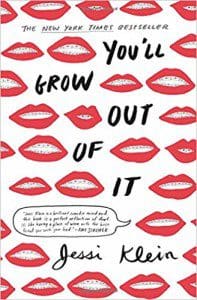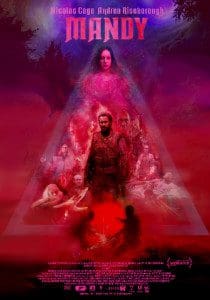We’d be lying if we said the highlight of June 2019 wasn’t our Annual Fundraiser & Celebration on the 21st! Thanks again to everyone who came out and made it such a memorable evening. But there were some other memorable experiences in June — so here’s a roundup of the works we’ve been reading, watching, and listening to:
 Arianna Casabonne, Intern: I’m midway through You’ll Grow Out Of It, The New York Times Bestseller by Jessi Klein, and I find myself absorbed with Klein’s raw and relatable writing. The book, a collection of twenty four essays, is as much about how Klein navigates the cultural norms of femininity as it is about making fun of them (and herself). In these revealing stories, Klein dissects her feelings growing up as a late bloomer, and the many awkward and cringe-worthy moments of figuring out womanhood. Immediately, the novel’s first essay, “Tom Man” delivers a heart-felt and funny recount of her transition from a “Pippi Longstocking-esque tomboy to are-you-a-lesbian-or-what tom man.” In this story, Klein admits to looking “like a mess during college,” and that it “didn’t even occur to [her] to eat anything other than breaded chicken patties on Wonder Bread buns followed by a piece of cake” for all four years of school. With a humorous self-awareness, Klein takes readers along as she describes her attempts at transitioning from a “Tom Man” to a “Grown Woman.”
Arianna Casabonne, Intern: I’m midway through You’ll Grow Out Of It, The New York Times Bestseller by Jessi Klein, and I find myself absorbed with Klein’s raw and relatable writing. The book, a collection of twenty four essays, is as much about how Klein navigates the cultural norms of femininity as it is about making fun of them (and herself). In these revealing stories, Klein dissects her feelings growing up as a late bloomer, and the many awkward and cringe-worthy moments of figuring out womanhood. Immediately, the novel’s first essay, “Tom Man” delivers a heart-felt and funny recount of her transition from a “Pippi Longstocking-esque tomboy to are-you-a-lesbian-or-what tom man.” In this story, Klein admits to looking “like a mess during college,” and that it “didn’t even occur to [her] to eat anything other than breaded chicken patties on Wonder Bread buns followed by a piece of cake” for all four years of school. With a humorous self-awareness, Klein takes readers along as she describes her attempts at transitioning from a “Tom Man” to a “Grown Woman.”
Along this journey are many embarrassing pitfalls, devastating heartbreaks, and a continuous unveiling of what it means to be a woman. In You’ll Grow Out Of It, womanhood seems to be a combination of the authentic, cringey, and heartfelt moments of navigating the dating scene, going to therapy, seeking advice from girlfriends, and finding love. At the same time, womanhood is swathed with pressure to participate in typically feminine activities, like lingerie shopping and barre classes. Klein critiques how the seemingly effortless perfection women radiate comes at a physical, emotional, and monetary cost. In “Bar Method and The Secrets of Beautiful Women,” Klein is shocked to find how hard women work in order to maintain their image. In New York City, Klein attends a barre workout class where each class costs $32 with a recommended five classes a week for the best results. Therefore, the women spend $180 a week on having toned bodies. In addition, there is what Klein describes as “taking a class where you are in horrible pain and hate your life and might lose your lunch at any moment.” Klein finds the class ridiculous and annoying, yes, but she is not immune. She sees the Bar Method instructors with their LuluLemon leggings and butts “like the very best of the produce section,” and she is swayed into continuing the class.
While Klein provides important critiques on hyper-femininity, she humorously highlights how she is still roped into it and affected by its ridiculous standards. Her stories intertwine humor with significant insights, creating a truly fun and compelling read. You’ll Grow Out Of It poignantly captures the uncomfortable and hilarious experience of becoming a woman, in a world where femininity and womanhood hold a multiplicity of meanings. In her own stories, Klein delivers wisdom with a humorous, self-deprecating edge. Reading You’ll Grow Out Of It feels like every long conversation with a best friend. It’s soul-barring, funny, and strikingly real.
 Julia Matthews, Intern: Only a year after its 2018 Sundance premiere, Mandy seems on its way to cult classic status. I saw it for the first time last weekend when I caught a showing at Oakland’s (wonderfully strange) New Parkway Theater. Directed by Panos Cosmatos and starring Nicholas Cage, Mandy is cinematic sensory overload. It is fearsome from its opening moments as cinematographer Benjamin Loeb and late composer Jóhann Jóhannsson plunge the viewer into a heavy metal universe drenched in staggering displays of color and light and scored by perpetually moaning electric guitar.
Julia Matthews, Intern: Only a year after its 2018 Sundance premiere, Mandy seems on its way to cult classic status. I saw it for the first time last weekend when I caught a showing at Oakland’s (wonderfully strange) New Parkway Theater. Directed by Panos Cosmatos and starring Nicholas Cage, Mandy is cinematic sensory overload. It is fearsome from its opening moments as cinematographer Benjamin Loeb and late composer Jóhann Jóhannsson plunge the viewer into a heavy metal universe drenched in staggering displays of color and light and scored by perpetually moaning electric guitar.
Mandy is the story of Red (Nicholas Cage) and Mandy (Andrea Riseborough), a couple living an idyllic, if remote, life of domestic bliss in a Pacific Northwest forest. Their intimacy is palpably conveyed through shimmery scenes of rowboat afternoons, pillow talk about the universe, and nights on the couch with dinner and a B-Movie. When a quasi-religious, Manson Family-esque cult roll into town –– followed later by a vampiric biker gang –– Red and Mandy’s quiet life together is excruciatingly and irrevocably destroyed. Red then embarks on a quest for revenge that plays out like a feverish nightmare (fueled by an entire bottle of liquor, a fistful of cocaine, and one drop from a horrible batch of liquid LSD). The film is purely psychedelic: saturated with deep, consuming blues, poisoned greens, and smothering reds, and steeped in the continuous synth rumble of Jóhannsson’s score. It’s Eighties metal from start to finish.
Although deliberately and at times painfully slow, Mandy is punctuated with unforgettable scenes, including a literal chainsaw duel. Cosmatos has pulled off an appalling feat of reversal: creating a film so tense and emotionally destructive that the climax’s unbearable violence actually brings the viewer tangible relief when it finally arrives (the whole theater even erupted into laughter at a few choice moments). Credit must also be given to Jóhann Jóhannsson; after so many minutes of liquid ambient sound left me yearning for a downbeat, the pounding drums that kick in to accompany Red’s march towards vengeance lifted me out of my seat. Above all, Mandy represents Nicolas Cage unleashed –– his raw, maniacal performance takes this from a slasher film to an Odyssean romance. Go see Mandy…but only if you have a strong stomach, a big screen, good speakers, and a hand to hold.
 Oscar Villalon, Managing Editor: Gabriela Gárcia Márquez’s The Scandal of the Century and Other Writings has been sustaining me in dribs and drabs, its pleasures neatly delivered in various pieces the maestro wrote for Spanish-language newspapers and magazines from the ‘50s through the ‘80s. They’re not really columns or articles; they’re more like feuilletons, those newspaper pieces shaped by their authors’ sharpened cultured and literary acumen to where the fact-based article you’re reading assumes the guise of belle-lettres. (That is to say, writing that is sorely missing from American newspapers.)
Oscar Villalon, Managing Editor: Gabriela Gárcia Márquez’s The Scandal of the Century and Other Writings has been sustaining me in dribs and drabs, its pleasures neatly delivered in various pieces the maestro wrote for Spanish-language newspapers and magazines from the ‘50s through the ‘80s. They’re not really columns or articles; they’re more like feuilletons, those newspaper pieces shaped by their authors’ sharpened cultured and literary acumen to where the fact-based article you’re reading assumes the guise of belle-lettres. (That is to say, writing that is sorely missing from American newspapers.)
He weighs in on many things, and the judiciousness in what was selected by editor Cristóbal Pera for this book (50 pieces plucked from the five-volume Obra periodística) is borne out in how Gárcia Márquez’s writings on Venezuela and Cuba and (of course) Colombia read as fresh—and relevant—these many decades later. The same is true of his pieces on the literary world (1980’s “The Specter of the Noble Prize”: “The bad thing is that the final result does not depend on the candidate’s own right, and not even on the justice of the gods, but on the inscrutable will of the members of the Swedish Academy.”) and the writing life (1966’s “Misadventures of a Writer of Books”: “Personally, I believe that the writer, as such, has no other revolutionary obligation than to write well. Nonconformism, under any regime, is an essential condition that can’t be helped, because a conformist writer is most likely a bandit, and most definitely a bad writer.”)
There’s an old saw that there’s a novel in progress in the desk drawer of every reporter. Gárcia Márquez would be an apotheosis of this maxim. “I am basically a journalist,” Pera quotes him as having said. “All my life I have been a journalist. My books are the books of a journalist, even if it’s not so noticeable.” What a marvel, then, to read these works, written under deadlines, presented to a mass audience, and see both in advance of his fame and after its establishment an immutable and rare greatness.
 Zack Ravas, Editorial Assistant: Over the last several years, A24 has made a name for itself as the premiere independent film distributor, with titles like Lady Bird and Hereditary to their name; so it came as a surprise when the label delayed the theatrical release of Under the Silver Lake, director David Robert Mitchell’s follow-up to his 2015 breakout horror film It Follows, not once but twice, only to then unceremoniously dump the film on Video on Demand services four months later. I suppose I can’t blame A24 for not knowing what to do with Under the Silver Lake: I’ve seen the film twice now and I still don’t entirely know how I feel about it. Although rumors swirled that the distributor had prodded Mitchell to deliver a new edit based on negative test screenings, the movie’s weighty 140 minute runtime –– and indeed the film itself –– suggest that not a moment has been trimmed from Mitchell’s L.A. slacker neo-noir. For both better and worse, Under the Silver Lake registers as David Robert Mitchell’s unfiltered creative vision.
Zack Ravas, Editorial Assistant: Over the last several years, A24 has made a name for itself as the premiere independent film distributor, with titles like Lady Bird and Hereditary to their name; so it came as a surprise when the label delayed the theatrical release of Under the Silver Lake, director David Robert Mitchell’s follow-up to his 2015 breakout horror film It Follows, not once but twice, only to then unceremoniously dump the film on Video on Demand services four months later. I suppose I can’t blame A24 for not knowing what to do with Under the Silver Lake: I’ve seen the film twice now and I still don’t entirely know how I feel about it. Although rumors swirled that the distributor had prodded Mitchell to deliver a new edit based on negative test screenings, the movie’s weighty 140 minute runtime –– and indeed the film itself –– suggest that not a moment has been trimmed from Mitchell’s L.A. slacker neo-noir. For both better and worse, Under the Silver Lake registers as David Robert Mitchell’s unfiltered creative vision.
The story follows the jobless and perpetually-behind-on-rent Sam, played by The Social Network’s Andrew Garfield, as he grows convinced the sudden disappearance of his new neighbor (Riley Keough) is not a random occurrence, but rather evidence of a vast conspiracy involving the Hollywood elite and the deeply coded messages they weave throughout pop culture. Under the Silver Lake possesses style to spare –– cinematographer Michael Gioulakis brings the same visual flair he exhibited earlier this year in Jordan Peele’s Us, and Disasterpiece’s knockout soundtrack deliberately channels Bernard Herrmann’s thundering scores for Hitchcock thrillers such as Vertigo and Psycho.
The swooping camera movements and evocative music place us in a familiar genre context: as we watch Sam pull at every disparate thread of this Hollywood mystery, we anticipate a shadowy cabal will ultimately be uncovered. No doubt The Powers That Be will be dragged reluctantly into the light, albeit for a brief moment, and Sam will suffer some kind of punishment for upsetting the status quo, before things continue exactly as they were before. It’s Chinatown. Right?
But Under the Silver Lake does something unexpected, and it’s the reason I find the film –– for all its faults –– difficult to shake. As Sam begins to penetrate the cover-up at the heart of the story, we realize the “conspiracy,” such as it is, is fairly innocuous and not all that grand. Furthermore, as Sam ferrets around Silver Lake literally assaulting anyone who upsets his worldview or refuses to indulge his paranoid questioning, a realization sinks in for the viewer: this insecure young man and his rampant sense of entitlement are more of a danger to the citizens of L.A. than the purported masterminds he’s attempting to reveal.
Like so many men of his generation, Sam has surrounded himself with analog detritus: his apartment is a catalog of old video game consoles, VCRs, vintage pornography, and Nintendo Power magazines. His desperate search of their contents for increasingly arcane codes has less to do with unraveling a conspiracy and more with an inherent need to attach these artifacts with some meaning beyond an empty consumerism. It’s telling that Sam reserves his harshest punishment for the one person who dares to insist the pop culture that means so much to Sam does not, in fact, serve any purpose beyond a means to make someone else money. It must be said that Andrew Garfield has rarely been better than he is here, successfully subverting his boyish and handsome persona with Sam’s nervy, manic energy and a barely repressed misogyny disguised as lovesickness.
There’s a menace plaguing Los Angeles, the film tells us; but rather than lurking in the shadows or the halls of power, its face might be as familiar as the boy next door. Under the Silver Lake is a challenging, frequently unpleasant viewing experience. It’s also one of the most interesting artistic statements of the year.
